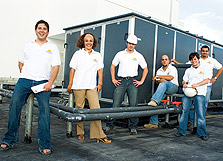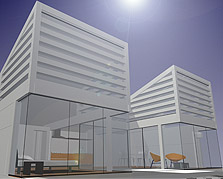

The cultural and academic diversity of Florida's team is reflected in its house design.

Florida's glass walls and doors connect the inside with the outside.
Solar Decathlon 2005
Florida International University
Blurring the Boundaries
The Florida Decathlon team's solar house, at first, appears to be a U-shaped house. But look a little deeper, and listen a little more carefully to the designers, and the house may appear as though it is a square-shaped house. If this sounds a bit Zen, wait until you hear why the house is named "Engawa."
Engawa is a Japanese term that describes space that is both inside and outside. It is the courtyard or entryway space that takes Florida's house from U to square. The walls separating the interior of the house from the courtyard are glass, so it can be difficult to tell where one space begins or ends. Double-swing glass doors can literally extend the interior space, as the courtyard and the living room become one big room. "The interior walls can be changed in any way," says student Robert Perez, project architect. "It's not in a fixed state. The house promotes interactivity."
Somewhat unusual for an energy-efficient house, the Florida house is about one-third glass. Although the design is appealing to the architecture students on the team, it's the kind of thing that gives an engineering student fits. In the usual wrangling between form and function, the students accepted the challenge to both keep the glass and keep the heat out. Operable windows and the use of blinds are a return to the historical ways of heating and cooling, according to student Diane Marshall, the team's outreach and communications director.
Some of the glass is in the form of PV-integrated windows, which the team will also use as a projection surface. "Usually the house is open and airy, but you can make it dark, if, say you want to project a movie onto the PV window," says Perez.
Marshall says the Engawa philosophy of removing boundaries extends beyond the design and into the team's interactions with each other and with the community. The Florida team reflects the diversity of Miami. Students are from different ethnic, cultural, and religious backgrounds and range from first-year students to Ph.D. candidates. Team members come from four disciplines: architecture, engineering, journalism and mass communications, and creative writing. "People in different fields see things differently. This is what makes the house strong, because we did come to a consensus," says Marshall.
Team Contact
Prof. Yong X. Tao, PhD
College of Engineering, EC 3445
10555 W Flagler Street
Miami, FL 33174
305-348-3015
